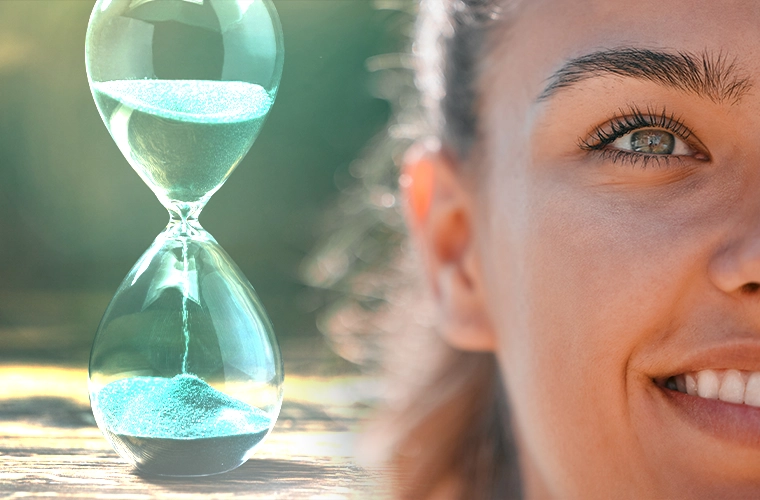New research reveals that observing different visual stimuli can significantly distort the human perception of time.
In findings published in Nature Human Behaviour, research psychologists from George Mason University discovered that viewing more prominent and memorable scenes can create the impression of time moving more slowly. Conversely, cluttered imagery compresses time perception, making it seem to speed up.
This revelation challenges conventional understandings of how time is encoded by the brain during sensory processing and opens new avenues for exploring the intricate relationship between visual perception and time.
“These findings suggest that visual circuits mediate or construct perceived time,” the study’s authors wrote. “[This] provides evidence for a link between image features, time perception, and memory that can be further explored with models of visual processing.”
The Enigma of Time Perception
Time perception, or chronoception, has long been a subject of fascination within psychology, cognitive linguistics, and neuroscience. It refers to how humans perceive the passage of time, a process integral to sensory experiences.
Historically, philosophers were the first to grapple with the concept of time. In 5th century BC Greece, Antiphon the Sophist argued that “time is not a reality (hypostasis), but a concept (noêma) or a measure (metron).”
The pre-Socratic Greek philosopher Parmenides went further, suggesting that time, motion, and change were illusions. Similarly, Buddhist philosophy often considers time an illusion, emphasizing the transient nature of existence.
Other theories, like philosophical presentism, propose that the past and future are constructs of the human mind and that viewing movement as the only actual dimension of time that coexists with the present.
Despite its importance, the scientific understanding of the mechanisms underlying time perception has remained somewhat elusive, leading to various theories being proposed over the centuries.
One prevailing theory in modern cognitive science is the internal clock model, which suggests that the brain contains a pacemaker that generates pulses. The accumulation of these pulses is then compared against a stored representation of time intervals to gauge duration.
Another influential theory is the striatal beat-frequency model, which posits that the brain’s basal ganglia and the dopaminergic system play a key role in tracking time by detecting the pattern of neural oscillations.
Contextual change models propose that time perception is derived from the amount of perceptual change or the number of events that occur within a given period.
One of the more intriguing theories is predictive coding, which proposes that the brain continuously generates predictions about future events based on past experiences, and deviations from these predictions help to calibrate our sense of time.
Ultimately, the lack of a single unified theory for the neurological underpinnings of time perception underscores the complexity and intricate neural processes involved in how we perceive time.
Experimenting with Visual Stimuli
In this recent study, researchers conducted four experiments to investigate how different image properties might affect time perception.
The first two experiments involved a visual temporal categorization task. Participants viewed images and judged whether they were displayed for a ‘short’ or ‘long’ duration. These images were sourced from the Size/Clutter database and rated for scene size and clutter. Participants viewed images at various intervals ranging from 300 to 900 milliseconds.
The results revealed that larger scene sizes caused participants to perceive durations as longer, while increased clutter led to the perception of shorter durations.
Experiment 3 focused on image memorability using the Large-Scale Image Memorability dataset (LaMem). Participants again categorized the duration of each image as ‘short’ or ‘long.’
The findings showed that images with higher memorability scores were perceived to last longer and were judged more accurately.
The final experiment involved a duration reproduction task. Participants viewed an image and then attempted to reproduce the duration by holding a button. The results indicated a strong link between the perceived duration of memorable images and their actual recall in a subsequent memory test.
Bridging Time Perception and Memory
Results showed that images perceived as lasting longer were better remembered, suggesting a bidirectional relationship between time perception and memory. This phenomenon could offer adaptive advantages, allowing the brain to enhance the encoding and recall of significant information by extending the perceived duration of memorable images.
The researchers utilized a recurrent convolutional neural network (rCNN) model to further explore this interaction. This model simulated the dynamics within the human ventral visual stream, revealing that more memorable images were processed faster and categorized more accurately. This faster processing speed predicted the lengthening and increased precision of perceived durations.
“Time has traditionally been seen as a ‘byproduct’ of perception. We integrate our senses (vision, hearing, touch), retain memories, form predictions, and then ‘time’ spills out of that process,” Dr. Martin Wiener, a professor of cognitive and behavioral neuroscience and study co-author, told PsyPost. “Our work suggests time might be built at a much earlier stage in the process and for each sense independently (visual time, auditory time, etc.).”
Implications and Future Directions
The study provides unique insights into how visual properties influence time perception. It challenges the traditional view that time is a mere byproduct of sensory processing and suggests that time may be constructed at an earlier stage in the process, independently for each sense.
These insights help to explain how the brain’s processing of visual stimuli can influence our subjective experience of time. This includes common temporal illusions, such as the perception that “time seems to slow down” during awe-inspiring moments or that “time flies when you’re having fun.”
The findings suggests that when people experience something awe-inspiring, the event is often both expansive and memorable, potentially leading to this sensation of elongated time.
Conversely, enjoyable activities that involve unfamiliar or cluttered imagery may compress time perception, making it feel like time is passing quickly. This aligns with the theory that cluttered environments or complex tasks demand more cognitive resources, speeding up our perception of time as we become deeply engaged and less aware of its passage.
Ultimately, these new revelations help unravel the complexities of time perception. They suggest that our experience of time is intricately tied to the sensory information our brains process, revealing the fascinating ways in which our perception of reality can be shaped by what we see.
Looking ahead, the researchers plan to expand their study to include a more extensive and more diverse participant pool to test the robustness of their findings. They also aim to employ neuroimaging and brain stimulation technologies to gain deeper insights into the mechanisms behind time dilation effects and explore the potential to alter these effects.
Finally, while the current study explains how more memorable images dilate time, understanding the underlying reasons for this phenomenon will require further research and theoretical development.
Tim McMillan is a retired law enforcement executive, investigative reporter and co-founder of The Debrief. His writing typically focuses on defense, national security, the Intelligence Community and topics related to psychology. You can follow Tim on Twitter: @LtTimMcMillan. Tim can be reached by email: tim@thedebrief.org or through encrypted email: LtTimMcMillan@protonmail.com

